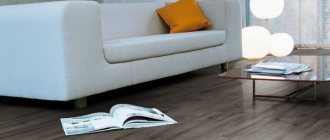Unfortunately, the appearance of even the most modern heating devices does not always meet aesthetic requirements, and sometimes cannot fit perfectly into the interior of the room. The desire of the owners to eliminate this deficiency is quite natural.
Before closing the radiator, you should understand all the intricacies of the issue. Otherwise, home heating costs may increase significantly. In our material we will tell you how to do this without special financial costs and heat loss.
The best ways to beautifully hide radiators
There are several ways to hide batteries; in this section we will look at the most popular and effective ones.
Hinged screen
It is by far the most practical and popular method; most often this design is made of metal and has its advantages:
- simple installation;
- heat exchange remains the same;
- can be made with rounded corners, which reduces the risk of injury.
Glass screens
A screen made of glass will be an interesting and stylish solution, especially for those who choose minimalism or a modern style in interior design.
Photo printing or various patterns can be applied to the glass, but this method is not a budget option.
Installation is carried out on a screw holder, but you will have to drill holes in the wall. However, the heating radiator will be stylishly protected. This option will fit into any interior.
Box screens
Box screens are an excellent option for decorating radiators.
- They will help to completely hide the battery.
- The box can become a piece of furniture.
- The screens are easy to install and easy to maintain.
- Protect from burns or other injuries.
Curtains to the floor
Let’s not forget about the most popular way to hide batteries - simply hang them with opaque or translucent curtains. Using this method, over time you will even forget that there are pipes and a radiator behind the curtains.
The main thing is to choose curtains that will look harmonious and not show everyone that there is something behind them.
Painting the walls in color
How to hide a heating radiator on the wall if other designs are “prohibited”. There is only one way to paint it the same color as the wall.
Wood frame
Wood will create coziness and warmth in the apartment, and the disguise of the battery will be elegant and beautiful. This option is for those who are furnishing their home in eco-style using natural materials.
These ways to hide batteries can be used as a stand for home decor.
Built in furniture
Another common way to cover a radiator is custom-made furniture or built-in furniture (shelves, cabinets, folding tables, seating).
Hide the radiator with furniture
Arrange furniture, such as an armchair or desk, so that it covers the radiator. A cast iron radiator is not attractive to many, but pieces of furniture can hide it.
Replace with designer model
For those who don’t want to invent anything, unique designer ways to hide batteries have been developed that already initially have a beautiful appearance and you simply don’t want to hide them.
No. 3. Radiator painting
with painting and decoupage , because it is very easy to cross the line from simply disguising the battery to protruding it. If a radiator with a pattern printed on it contrasts sharply against the background of the wall, it will catch the eye, although initially a completely different task was set. Such a battery seems to suggest that it greatly disturbed the owners, and they tried to hide it.
Designers recommend painting not only the radiator itself, but also part of the wall against which it is located. The drawing can be made in any technique and color scheme. If you have talent, then we pick up paints and start creating: do not forget that the paint must be resistant to heat. If you don’t have any special artistic talents, then you can use ready-made stencils for drawing, use the decoupage technique, or even vinyl stickers . The main thing is that everything looks harmonious, and the battery turns out to be truly camouflaged.
Original ideas
There are many creative ideas that can turn batteries into a decorative element:
Forged products
Hide the radiator with fabric
Painting and decoupage of batteries
Installing a reflector on the wall increases the efficiency of the radiator
Decorative grilles for batteries
When closing the radiators, care must be taken to increase the heat flow in the room. The first is the placement of a special shielding thermal insulation material on the wall. The simplest and cheapest consists of a sheet of foam rubber covered on one side with foil.
Foam rubber glued to the wall is a good heat insulator. It does not allow cold to reach the battery. The shiny foil reflects the heat and partially returns it to the radiator; the rest is carried upward by the air flow. The heater sections become even hotter.
If you decide to cover the battery with a metal screen, paint the back side black. It attracts heat and absorbs it. The efficiency of heating systems will increase.
We also recommend reading:
How to sheathe the inside of a house with plasterboard beautifully and for a long time How to arrange a basement in a private house with your own hands Insulating a house with mineral wool. Sheathing guide Insulating a house with polystyrene foam: how to properly sheathe a house with polystyrene foam with your own hands? Do-it-yourself Art Nouveau houses with half-timbered elements
Masking of radiators and the laws of heating engineering
The main task of any heating radiator is to heat the room. The goal is achieved by combining or separately using two methods - infrared radiation and convection. Thanks to them, comfortable conditions are formed.
Infrared radiation transfers heat to objects in the room, while convective radiation heats the air.
We can feel thermal energy if we place our hand in close proximity to the radiator. Convection ensures air circulation and uniform temperature distribution throughout the room.
This is known from school physics courses - warm air, rising upward, displaces colder air.
The screen for the radiator performs several important functions: it links the device with the design, protects it from damage and settling dust, the combustion of which releases toxins.
You need to understand that almost any method of hiding pipes and radiators will lead to an inevitable loss of heating power. The simplest example is the use of a glass screen with artistic painting.
It would seem that the task of decorating the radiator was completed successfully, but the room immediately became noticeably colder. This all happened because glass almost completely neutralizes infrared radiation.
An original way to disguise a heating radiator will help to expand the window sill and use the structure as a piece of furniture.
The deeper and more securely the radiator is hidden, the greater the losses will be.
This statement fully applies to blind screens that prevent both long-wave infrared radiation and short-wave convection.
Maximum perforation of the grille and the presence of gaps in the upper and lower parts of the lining are the key to normal convection.
The same can be said about the blind boxes above the top of the radiator - they are an insurmountable barrier to the spread of warm air upward (the convection method does not work). The conclusion suggests itself - the larger the area of the holes in the lining, the smaller the heat loss will be.
Battery screen design
Over the years, canvases that hide radiators have become a stylish addition to interiors. There are various ways to turn a screen into a real decoration. First of all, this concerns wooden products, which are often complemented with carved elements in classic interiors. Fine carvings add some lightness and sophistication to the decor. Canvases matched to the color of the furniture look good. Glass screens are endowed with special decorative properties, which can be supplemented in the following ways:
— Photo printing – will decorate the canvas with magnificent landscapes, city panoramas and any other images at the request of the customer;
— Handmade drawings are quite an expensive pleasure, but the end result is worth it. This method of decorating a screen involves the artist applying a picture with silicate paints. The stained glass is then fired in a special oven;
— Sandblasting with the addition of paints allows you to create a wide variety of patterns;
— Decorating with lead self-adhesive film is an expensive type of screen decoration. Its cost is explained by the high cost of raw materials, but the drawings have a rich colorful palette.
Beautiful stained glass designs are created using the bevel method. This is a rather complex technology, during which individual glass elements are first cut, then coated with a special glue and mounted to a metal profile. Completely unique screens are made using rhinestones that can imitate the cutting of precious materials.
If you are planning to decorate the battery screen yourself, you can do this by simply painting it, for example, to match the color of the interior. You can apply an original drawing in the form of a piano. For work you will need white and black paints. The image needs to be carefully thought out in advance so that the keys are located realistically in the correct sequence.
Another interesting technique - decoupage - will give the panels some chic. To do this, you need to purchase multi-layer napkins with a pattern. Then everything is simple: the screen needs to be washed and dried (can be painted). The top layer of the napkin is separated, applied to the surface of the canvas and thoroughly coated with a layer of PVA glue. At the same time, it is necessary to remove air bubbles. Once the applique is completely dry, it can be varnished to extend the durability of the design.
Requirements for the decoration of heating radiators
The availability of pipes and radiators is another important point in choosing decor after the requirements of heating engineering. It is well known that the heating radiator, namely the connection with the pipe, is the weakest point.
In addition, the radiator itself, due to improper installation and operation, or for a number of other reasons, may leak.
In emergency cases, it may be necessary to remove the radiator for repair or replacement. From a plumbing point of view, the cover or screen should not have a fixed attachment, ideally the use of attached screens.
Even if you decide to ignore the advice of a plumber, still listen to the voice of reason, which suggests that any weak point in the system is the connection nodes. The presence of an inspection (plastic door) can significantly simplify the task of servicing the radiator and heating system in the future.
A little about heat engineering and radiator grilles
Even if you need radiator grilles for decoration, do not forget that the radiators must heat the room. Any screen reduces heat transfer, even the most delicate and delicate one. Another question is that one will reduce the amount of heat transferred by 10-15%, and the other by 60% or even more. It is unlikely that you will want to sit in a beautiful but cold room, so when choosing a decorative grille you need to take into account how the heat will spread.
Heat Spread
The principle of heat transfer from a heating radiator without a grille is shown in the figure. The main idea is that air should come from below, pass along the battery, heat up, and go up. This is how our heating works. When choosing a grille or screen, you need to remember this. For normal air circulation, it is necessary that there is a gap at the bottom and no cover at the top. As a last resort, the lid should have a large perforation area.
Not a bad option - large holes allow air to move freely
But if you look at many of the decorative grilles, you can immediately tell that the room will be cold. This especially affects grilles on heating radiators in the form of a box, which have walls on all sides. If they are very lacy, as in the photo above, there is no particular problem, but if they are made of solid wood (as in the photo below), with almost no or minimal perforations, be prepared for heating inefficiency.
The top of the battery is covered with a solid layer of wood without holes
Wood is, of course, an aesthetic material, but it has a high heat capacity. Until the wood heats up, the room will be cold. And since the array is located above the radiator and there are no holes for circulation, the radiator under such a grille will be hot, but the room will be cold.
How to close batteries correctly - technical rules and tips
Before closing the radiator, you need to take into account several technical nuances:
- Keep in mind that the heat transfer of a closed radiator is reduced in any case, no matter what masking method you choose. The main thing is that the change is not significant.
Ideally, the decrease in air temperature in the room should be about 1-1.5 degrees.
- Before closing the battery, put it in order: blow it out, wash it (this is done at the end of the heating season) and paint it.
- Keep in mind that the denser the grille weave, the better it masks the radiator, but the worse it conducts heat. Therefore, when choosing a screen for a battery, try to look for a middle ground or rely on heat saving.
- To minimize heat loss, the screen can be placed on legs and a groove can be cut in the center.
When closing the battery, it is very important not to block convective air flows, otherwise it will blow in the room and the windows will begin to fog up, which will ultimately lead to the appearance of mold on the walls. Ideally, the window sill visor should protrude no more than 30 mm above the radiator; the top and bottom of the radiator should be as open as possible.
- There should be a distance of at least 35-50 mm between the battery and the screen. There should be a gap of about 60-70 mm from the radiator to the floor and to the window sill.
To resolve emergency situations, it is necessary to provide free access to the radiator. For example, the box grille can be removable, folding, opening on hinges or retractable on profiles.
At a minimum, for trouble-free maintenance, the following must remain in good accessibility: pipe connections, valves, thermal head and threaded connections.
You can increase heat transfer by 20-25% by placing a heat-reflecting screen, for example, fumisol, on the wall behind the radiator. Often this is quite enough to completely compensate for the heat loss of a closed battery.
A little about the heat transfer of radiators
There are often cases when new aluminum or bimetallic radiators are knocked out of the interior, disrupting its harmony.
The issue of finishing is quite relevant and requires a special approach, since installing a decorative casing on a heating radiator ensures its pleasant appearance, but disrupts the process of heat transfer from the device to the room. Let’s try to figure out why this happens and whether it can be avoided before we start making the screen. The thermal energy released into the room by a heating radiator has 2 components: radiant and convective. The first is characterized by direct infrared radiation entering the room from the hot surfaces of the battery. At low coolant temperatures (up to 50 ºС), the share of radiant energy is small, but at 60 ºС and above it increases significantly. When a decorative box for a battery is installed, the path to the flow of this radiation is inevitably blocked, which means that part of the thermal energy does not enter the house.
A good article on the topic of comparing the heat transfer of radiators.
The exception is convector-type water heaters; their front surfaces are not hot and there is practically no radiant component. But such heaters are rare.
The convective component is the transfer of thermal energy to the air environment. Battery panels also have an impact on it, as they create an obstacle to the air passing through the fins and other elements of the heating device. And in the case when the design of the screen is unsuccessful, part of the hot air simply accumulates inside the box, unable to escape outside.
The short conclusion is this: by installing decorative screens for radiators, we disrupt the heat exchange process and part of the energy is returned to the heating network through the return pipeline. This is not so scary in a private house, where the system is located throughout the house and this heat will not leave it anywhere, but will simply be transferred to another room. But in the case of an apartment, we simply give away the heat we paid for to our neighbors on the riser, this must be understood.
Hide with drywall
Separately, I would like to talk about how you can hide batteries using drywall. It’s worth noting right away that the material has its drawbacks, but plasterboard construction is still very popular for repairs.
- The material is environmentally friendly and is not subject to combustion.
- You can find several varieties of this material on the market.
- This camouflage option is budget-friendly, and installation can be carried out in different ways, in a way that is convenient for you.
- Also, it is drywall that will allow the apartment owner to come up with any design, which will help not only to cover the pipes and radiator, but also to make additional decorative elements.
The downside is that drywall is afraid of external influences; if you do it carelessly, it is quite easy to break or pierce it.
And if a breakdown or leak occurs, the entire finish will have to be replaced again, but this material is cheap.
Design options
There are many technologies that make it possible to decoratively cover heating radiators with plasterboard and at the same time guarantee the design thermal conditions. The most expensive is considered to be an individual order for a custom interior. But for reasons of economy, in most cases they design the batteries on their own:
- Construction of a suspended screen structure.
- Creating a wooden removable panel.
- The use of plasterboard boards is for arranging the box.
It would be worth noting that the latter option is considered especially popular today. At the same time, he cannot be considered the most impeccable.
How to cover a battery with plasterboard
The protective structure must meet the following characteristics:
- Jets of hot air should not have obstacles in their movement.
- Absolutely all threaded connections must be easily accessible.
- When developing a protective system, it is necessary to provide access to the battery control valves.
There are two options for using plasterboard that can be used to cover a radiator: a decorative wall made of gypsum plasterboard or arranging an ordinary plasterboard box with a removable metal lattice covering. The choice will depend on the location of the battery with communications in the apartment.
Do-it-yourself installation of a plasterboard box
In order to close the battery, you need to measure it, and then buy metal profiles and other additional products.
What materials are needed:
- 12 mm plasterboard sheet,
- metal profiles 27x28 and 60x27,
- self-tapping screws for drywall and metal,
- dowel-nails size 6x40,
- construction serpyanka,
- perforated corners.
Tools:
- screwdriver,
- hammer drill,
- metal scissors,
- stationery knife,
- construction stapler,
- pencil,
- roulette,
- building level.
Attention , for the construction of a plasterboard box there is an important requirement : the window sill must extend beyond the radiator by at least 3 centimeters.
Work order:
Installation of the frame. The profile should be mounted on three adjacent sides: floor, wall, window sill.
- Press the 27x28 metal profile to the base with your hand, drill a hole using a hammer drill in both the profile and the wall.
- Using a screwdriver, screw the dowel-nail into the hole.
- At the bottom of the window sill, a 27x28 metal profile is mounted on self-tapping screws; the length of the screws should not be greater than the thickness of the window sill.
- Next, you can install jumpers made of metal profile 60x27.
Selecting the grid size. This hole must be made slightly smaller than the grid size.
You can focus on three recommended sizes: 60x120, 60x90 or 60x60.
Installation of drywall. Plasterboard sheets can be cut with a utility knife. Screw it in with a screwdriver.
Installation of corners. They must be secured at the corners with a construction stapler, or attached to gypsum plaster.
- Serpyanka should be applied to all seams of the plasterboard box and covered with plaster.
- Before painting or wallpapering, the plasterboard box must be puttied, sanded and coated with primer.
Types of structures and materials
The main element of the screen is a facade in the form of a flat decorative panel with holes that provide natural air convection. The top and side panels are not always used - it depends on the location where the battery is installed. For example, the presence of a wide window sill and a niche make them optional.
The following screen mounting methods can be distinguished.
1. Mounted. The screen, alone or together with the box, is hung with emphasis on the battery or on the wall with hooks.
2. Floor. The screen acts as a facade on the box in the form of a kind of narrow bedside table.
3. Installed. The battery is hidden inside a niche, and the screen is a decorative part of the overall surface of the wall.
The supporting structure of the box can be made of wooden beams or aluminum corners - it depends on the materials of the decorative panel and its frame. The panel itself can be made from different materials: wooden slats, plywood, laminated fiberboard or chipboard, metal mesh.
During installation, a frame made of galvanized steel profile or wooden beams is usually used as a supporting structure (similar to the technology for installing plasterboard partitions).
Decorative glass screens can be distinguished as a separate type. This is the only type of material that is used in pure sheet form, without holes. And in order not to disrupt convection, the panel is installed without the top and side walls. Installation takes place using special fastenings on load-bearing elements made of cold-rolled decorative pipe, which provide the necessary ventilation gap between the battery and the panel.
Masking heating pipes
It doesn’t matter whether it’s an apartment or a house, a bedroom or a kitchen, everywhere I would like to have a good renovation. Questions immediately arise: how to beautifully hide heating pipes and how can this be done with minimal cost and maximum efficiency?
At the same time, the method of disguise should be truly invisible and unnoticeable, fitting into the room.
The pipe can be hidden inside the wall, or it can also be closed into the floor. Remember that the old heating system should not be hidden in this way; this option is possible after a complete update of all elements.
Box on frame
It is best made from wood, plastic or plasterboard. Do not place the heating pipes close together; there should be at least three centimeters between the box and the pipe.
Hide behind decor
Decoration of pipes in various ways, for example, wrapping them with jute rope. But remember that this reduces heat transfer. Many owners decorate pipes with flowers; this can be done using bamboo with leaves.
Only imagination should work here; even an old pipe can look completely different.
Painting to match the color of the walls
The easiest and most practical method is to paint the radiators or riser in the same color as the walls, but the heat generation will not be reduced.
Hide under the floor plinth
A good invention was the floor plinth, in which you can easily hide batteries located horizontally and low to the floor.
Marking
There are no strict requirements in the regulatory documents for placing the battery under the window - it is important that its edge does not extend beyond the border of the opening on the side of the riser pipe. But when installing it, they try to make sure that it is located symmetrically relative to the window
Likewise, the installation of plasterboard boxes under the battery must maintain symmetry with respect to the vertical axis of the window. Therefore, first you need to find and mark on the wall and floor the center of the window opening, from which the marking should be made.
If the battery is not installed under the window, then its center will be the axis of symmetry of the box. The marking sequence is as follows:
- Mark a line perpendicular to the wall on the floor in the center of the opening or battery;
- From this line the depth of the frame is measured without taking into account the sheathing;
- From the resulting point, draw a line parallel to the wall;
- On this line from the center, half the length of the box is laid in each direction without taking into account the lining and finishing;
- From the obtained points, draw two perpendicular lines to the wall, and from them, using a level, draw two lines on the wall to the window sill.
As a result, the projection of the installation location of the box should be shown on the floor and wall behind the radiator.
Photos in the interior of the rooms
Kitchen
The kitchen is the ideal room in which all ways to hide batteries will become practical and convenient.
If the room is small, then you can hide the radiator with the help of a beautiful tabletop or make a folding table, which will fold out when convenient.
Factories of metal-plastic structures offer a large selection of beautiful large-sized window sills that imitate stone, wood and other materials. A modern window sill does not break under weight, is not afraid of external factors, is easy to care for, wipe clean, is not afraid of scratches, and so on.
You can hide any type of battery in this way, including cast iron.
Living room
If the radiator is in a niche, then a wide window sill will help create a work area.
You can place souvenirs, vases or potted flowers on the constructed wooden box. You can also cover unsightly radiators in the living room with thick curtains.
The photo shows a modern living room. In order to hide the radiators, a wooden structure was installed, which also serves as a place for rest, storage and decoration.
Bedroom and children's room
In the interior of a bedroom and children's room, batteries can be used as another place to relax, a tabletop for decorative elements or a workplace.
Bathroom
You can hide the pipes in the bathroom using a louvered door, plastic grilles or a cabinet with opening doors.
We hide heating radiators using wooden, glass or plastic screens.
Hallway
For radiators in hallways, glass screens or wooden boxes are suitable. In a small room, covering the battery is only necessary from a practicality point of view.
This could be a locker for storing shoes, or the battery will become a small coffee table where keys and other necessary items will be stored.
Using special screens
The screen for the battery must match the design of the room and allow heat to pass through well.
To cover heating radiators in a house or apartment, you can use decorative screens. Choose the one that suits you based on two parameters – design and material of manufacture.
Design features
Masking shields are classified according to the method of fastening to the batteries. According to this principle, screen boxes and hanging products are distinguished.
The decorative box consists of a frame with a large-mesh lattice on the front side. Such products are used when it is necessary to hide the unaesthetic appearance of the battery, and sometimes even the heating circuit pipes. The boxes are installed along the window sill or cover only the radiator. They can be equipped with opening doors, which makes cleaning and temperature control of the coolant easier.
There are two types of hanging grid screens:
- models in the form of a horizontal panel located on top, with a decorative grille built into it;
- options consisting only of the facade part, which are called shields.
The first option is used to hide radiators located in niches or not covered by a window sill on top, and is installed directly on the radiator.
Flat screens mounted to the wall are often placed on radiators under the window, not covered by the window sill. They are also used to hide batteries installed in niches.
Material of manufacture
Plastic screen
To choose a decorative element based on this indicator, you need to take into account the characteristic features of the material.
To mask batteries, screens made of the following materials are used:
- metal;
- wood;
- MDF;
- glass;
- plastic.
To cover unsightly heating radiators, apartment owners most often prefer simple white metal boxes. Such options cannot be called sophisticated, but they are inexpensive and give off heat well. If strength and appearance are important, and cost does not matter, it is better to opt for a stainless steel product, which is characterized by a long service life and aesthetic design. Typically, such decors are used to hide cast iron radiators.
MDF is the most practical and inexpensive material that has all the advantages of wood and at the same time is not afraid of moisture and temperature changes. Screens made of such material are less susceptible to deformation and bending. There are openwork options made from MDF on sale.
Glass panels for heating devices are distinguished by maximum design variability. They are made entirely from glass or with the addition of other decorative materials. The location of the corners must be such that it is impossible to get hurt or caught on clothing. Usually, drawings and patterns are applied to the surface of the product. To prevent glass from breaking or scratches, it is covered with a laminate. In addition to laminated glass, triplex or acrylic is often used.
Plastic screens are the cheapest, but at the same time dangerous option. The shield is subject to deformation from the heat of a hot radiator and releases harmful components into the air. It is not advisable to use such screens where people stay for a long time.
How to beautifully decorate radiators
Installing a decorative box to cover heating radiators is not the only solution, and not everyone can come up with something and do it on their own.
There are several more ways on how and with what to decorate radiators under the window.
Radiator painting
One of the important issues in decorating a room is the combination of colors. Well, how can a white radiator look, for example, on a dark wall? Although for some reason white color is considered ideal for batteries...
The choice of heat-resistant paints on the modern construction market is huge; all that remains is to choose the right shade and tint the white base.
Even if you don’t guess the shade by a couple of tones, it’s okay, such a difference seems not noticeable at all. But it will still be better than just white. Well, if you wish, you can also manually paint the batteries, especially if there is an ornament on the wallpaper. To make the work easier, you can use a stencil.
Remember: if you decide to paint the radiators in your apartment, buy only heat-resistant paints.
By the way, you can paint not only ordinary cast iron radiators, but also steel, bimetallic, and aluminum ones.
Fabric screen
Another decor option is sewing and attaching a fabric screen screen. This masking method has been tested and is quite effective in terms of minimal heat loss, since the fabric, even the densest, still allows warm air to pass through (unlike a hard screen).
Previously, when heavy curtains were in fashion, all the radiators and the pipes suitable for them were hidden behind them.
And now, when Roman or roller blinds that do not reach the floor are used everywhere, we have to invent something. A practical solution is to attach Velcro to the bottom of the window sill and sew the other half of the adhesive tape to the fabric to create a removable fabric screen.
You can choose the material for it according to your taste and financial capabilities - from thin curtains, to natural linen or cotton, or vertical strips of blinds. The only condition is that the fabric can withstand temperatures up to 60 degrees.
Well, having arranged the space under the window in this way, you can choose roller blinds or window blinds as protection from the sun, without worrying about the unsightly appearance of radiators.
Heating battery box
Most often, such structures are either mounted on the wall or are attached, making it easier to maintain communications. Such boxes are made mainly from MDF, chipboard, wood or plywood.
The first option is the most practical, since MDF does not dry out and is not exposed to temperature changes, and it can be given any shape.
A prerequisite for such a design is the presence of perforations (holes), and the larger they are, the more heat will enter the room. There must be a hole at the bottom for the influx of cold air, and at the top for the exit of warm air.
You can use ordinary wooden blocks as a frame for the box, and if you have the skills of a carpenter, you can build a box according to individual dimensions: it can be either a structure the entire width of the room, covering both the radiator and pipes, or a box covering only the radiator.
Usually, the installation of a box that hides radiators is accompanied by dusty work, so you need to think through the design and create a sketch at the beginning of the repair. A decorative box can not only hide nondescript radiators that are unnecessary to the eye, but also become an element of interior decoration.
Hard screen
The most common (but, unfortunately, not the most practical) solution is to install a hard screen; hardware stores even offer ready-made solutions from a variety of materials. Each of them has its own disadvantages and advantages over others.
- Made of metal. For production, as a rule, stainless steel is used, followed by painting or chrome elements. Such structures look like ordinary mesh boxes. Of course, a metal object under the window is not suitable for every room; the ideal style for such a solution is hi-tech or loft.
But this design conducts heat well and will last a long time.
- Made of wood. Wood has always been considered a win-win option, as it fits into almost any interior. Wooden screens are a structure in the form of wooden lamella panels, horizontal or vertical, located at a sufficient distance from each other. Thanks to good perforation, such a grille does not interfere with proper convection; a wooden screen for a heating radiator will be a reasonable solution.
The only condition is that it must fit perfectly into the environment. This can be achieved by making a custom-made design with tinting to match the furniture.
- Made from glass, it will fit perfectly into the interior of any room. The glass can be frosted or colored, almost completely covering the radiator, or it can have a pattern that matches the style of the room. However, along with the elegant and airy appearance, there is one huge drawback - heat loss in the absence of perforation will almost double. Even the thermal gap at the top and bottom of the screen does not help the situation.
You can improve air circulation by using not solid glass, but glass panels located at some distance from each other.
- From plasterboard. Of course, we are talking, rather, about drywall as the basis of the screen itself, and with the help of other materials you can make a decorative panel-overlay that covers the batteries flush with the box itself.
When installing such a structure, you need to remember all the laws of heating engineering and safety, leaving access to communications in the event of a leak or the need to replace batteries.
No. 5. Glass screen for radiator
One of the most modern options for masking a heating radiator is the use of a glass screen. They are made from durable tempered fire-resistant glass with machined corners, so the screen will not easily get hurt or break. This method of masking is not capable of significantly disrupting the spread of heat flows throughout the room and will fit into almost any interior style and any room.
The glass screen is quite easy to install; it is mounted on special screw holders, which are necessarily equipped with elastic gaskets that protect the glass surface. Caring for such a screen is minimal and consists of periodically cleaning it from dust and fingerprints, using glass cleaning products. The only drawback is the price.
To be able to hide a radiator using glass, you need to pay attention to the method of decorating the surface. Of course, you shouldn’t leave the glass without a pattern: in this case, the outline of the radiator hiding behind the screen will be clearly visible, and the screen itself will play the role of attracting attention to the battery. It would be advisable to at least give the glass some tint. Among the ways to decorate glass are:
- photo printing You can apply absolutely any design to the glass, even a photograph you took yourself, so you can perfectly fit the screen into the existing interior;
- stained glass You can use expensive stained glass techniques (fusing, Tiffany technique or faceted stained glass), or you can create a pseudo-stained glass window on glass using films or paints, which is much cheaper, but the effect will not be worse. Another option is sandblasted stained glass, perfect for modern interiors;
- independent decoration. Usually, screen decoration is entrusted to companies specializing in this matter, but you can decorate an ordered matte screen with your own hands. This is a sticker for stained glass films, rhinestones, etc.
The same rule applies to glass screens as to hanging metal screens: it must fit harmoniously into the space under the window, so it is advisable to choose glass with a width equal to the width of the window sill. If you highlight only part of the space under the window sill where the battery is located with glass, you will get the opposite effect to what you expected.
Examples in different interior styles
Modern style
For a modern style or a high-tech and minimalist style, any material made of wood, glass (glass panels) or metal is suitable.
Classic style
It is recommended to use natural materials; it is better to opt for a wooden lattice.
Provence
Wood also loves styles such as Provence, country, chalet and eco-style.
Scandinavian
Wooden grilles in light colors will look appropriate in the Scandinavian style.
Loft
In the loft style, old radiators and pipes are most often not covered; they are left on display or replaced with interesting design options.
Efficient radiator screen design
A cross section of a radiator with a heating screen, namely how everything should be arranged, can be seen in the figure. The main design will have two highlights - an aerodynamic visor and an injector for convection of warm air. They can be made from cardboard, tin or galvanized. If you made it from cardboard, then be sure to cover the inside with foil. You can also use a regular baking sleeve.
Making a visor is necessary for any type of radiator. For both aluminum and cast iron batteries. If there is no canopy, then a thermal air cushion will constantly form in the corner under the window sill, which will block convection.
The main function of the injector is to suck in warm air flows from the radiator, namely from its front side. At a low temperature of the radiator itself, the effect will work weakly, but as soon as the heating increases, the draft will become much more powerful and warm air will flow from above the visor. You have probably noticed more than once how during the heating season the curtains on the window sway from the flow of warm air.
A radiator with a regular screen will not work efficiently, but if there is a reflective screen and a visor, then the battery efficiency will be even greater than without a screen. The injector and visor do not have specific dimensions. In any case, they can be moved or bent.
You can attach the radiator screen to the wall by any means, both with anchors and studs. In any case, the screen will work effectively if the total area of the front surface is less than the total space between them. If the radiator is made of cast iron and the fins are naturally located vertically, then the screen sheathing should also be made vertically.
Be sure to choose a screen for radiators, taking into account the heat transfer features. Otherwise, everything will turn out beautifully, but the room will not be heated. After all, everyone knows that the main guarantee of a prosperous winter is comfort and warmth in the apartment.
If you find an error, please select a piece of text and press Ctrl+Enter.
Around the battery, decide on the size of the future decorative grille. This place should be made slightly smaller than the size of the grate. There are three main standard sizes of gratings: 60x60, 60x90, 60x120. These dimensions are optimal for apartment renovations, and I recommend focusing on them. In fact, there is a way out!
It is necessary to make a box of plasterboard that will cover the entire problem area from the floor to the window sill from view. This solution to the problem has a huge advantage. In the end, it will be very beautiful, including thanks to the presence of an overhead grille, which I recommend matching to the color of the furniture. The dimensions of the box will depend on the battery that needs to be hidden
It is important to consider that the edges of the box will be approximately 15 cm further from the battery, on all sides. In addition, the box is marked on the floor so that the end of the box on the front side protrudes 15 cm relative to the radiator
How to close a radiator: photo gallery
Maintenance and Troubleshooting
In centralized heating systems, the coolant is ordinary process water, the purity of which is far from ideal. Having passed along the heating main, to the elevator unit and risers, by the time the water ends up in the battery, it is enriched with various suspensions, which settle in the radiators.
Because of this, the devices need to be washed every few years. This process requires access to the flush valve located in the lower corner of the radiator on the opposite side of the connection. Thus, if there is no easy access to the device, you need to either remove the protective screen (and this is not always possible) or put up with poor heating efficiency. For this reason, when choosing how to cover the radiator in a room, you should give preference to a product that will allow you to easily access the heating device.
We also must not forget that sooner or later the radiator will fail. And since heating appliances are usually hidden because they are too old and unattractive, the time when repairs are required will not be long in coming. Main types of faults:
- risers welded from an electric-welded gas supply pipe sometimes begin to leak along the factory seam (read: “Eliminating leaks in the heating system, sealing connections”);
- the steel pipes on the thread in front of the radiator are thinner than the straight sections of the riser, and leaks appear in them first of all;
- Cast iron batteries are characterized by frequent leaks from under the locknut;
- In spring and autumn, leaks often occur between sections of the radiator - paronite gaskets no longer provide a tight seal after just a few years of operation of the heating device (for more details: “The heating battery is leaking, what to do, how to eliminate the leak in a short time”).











